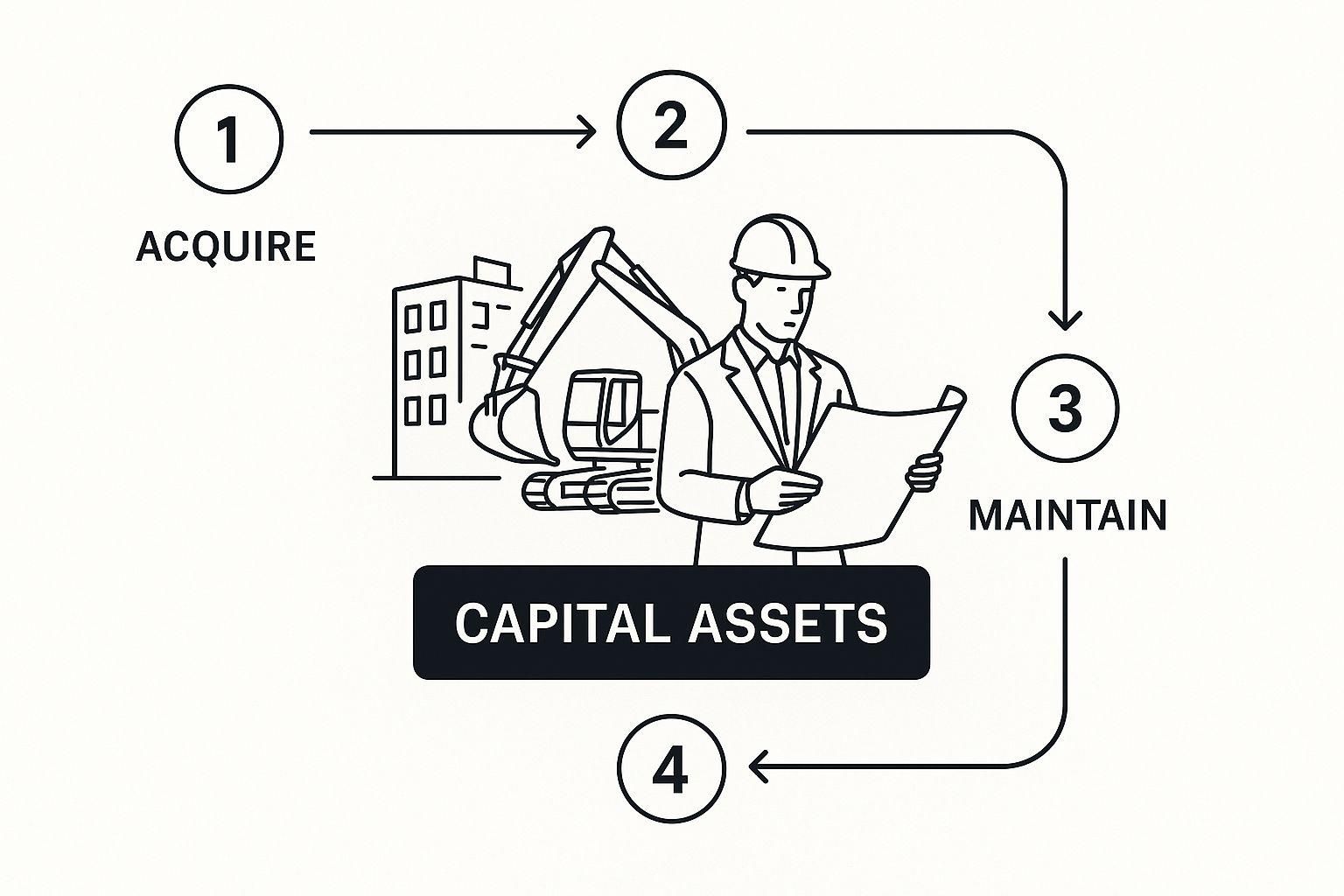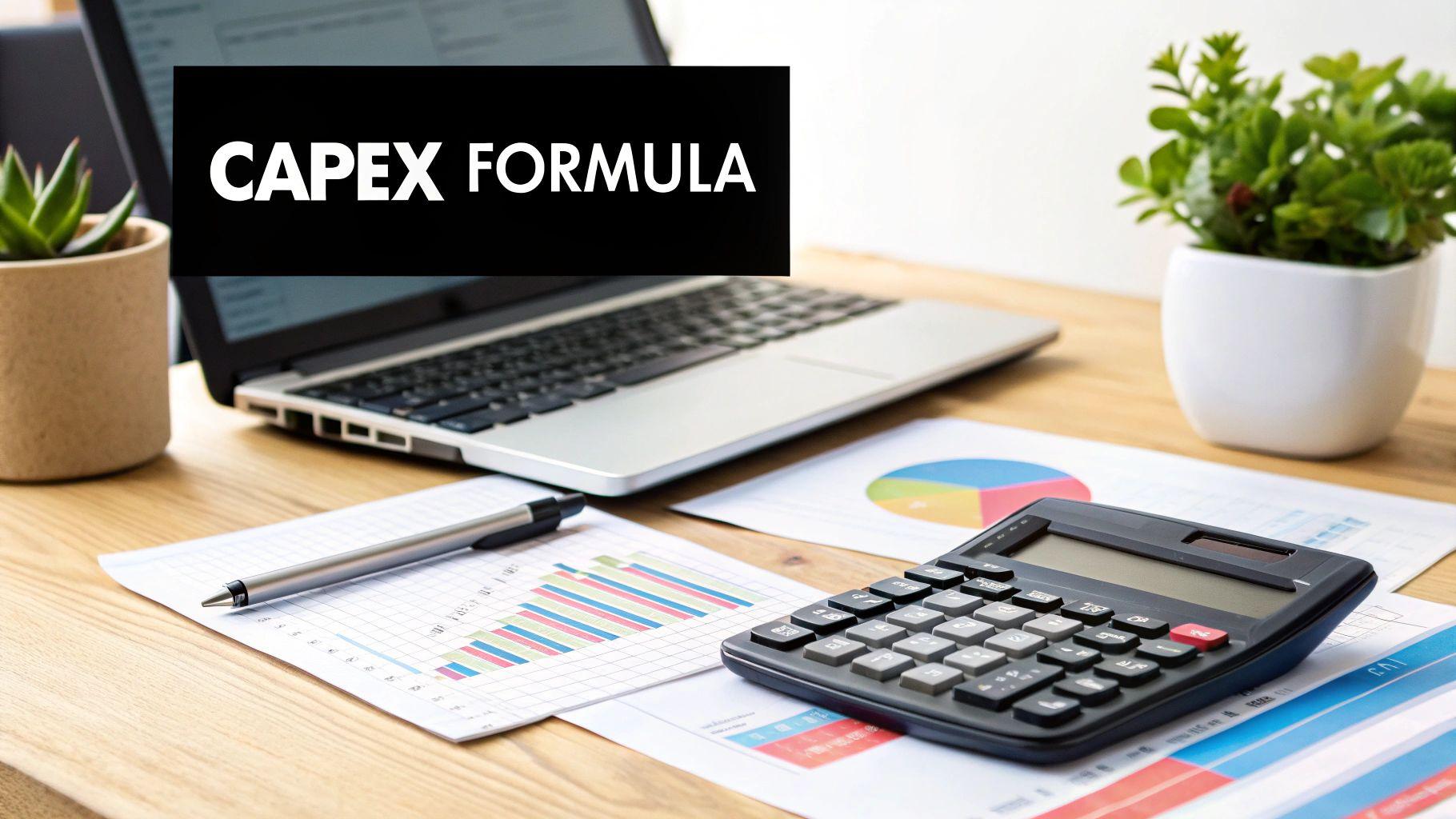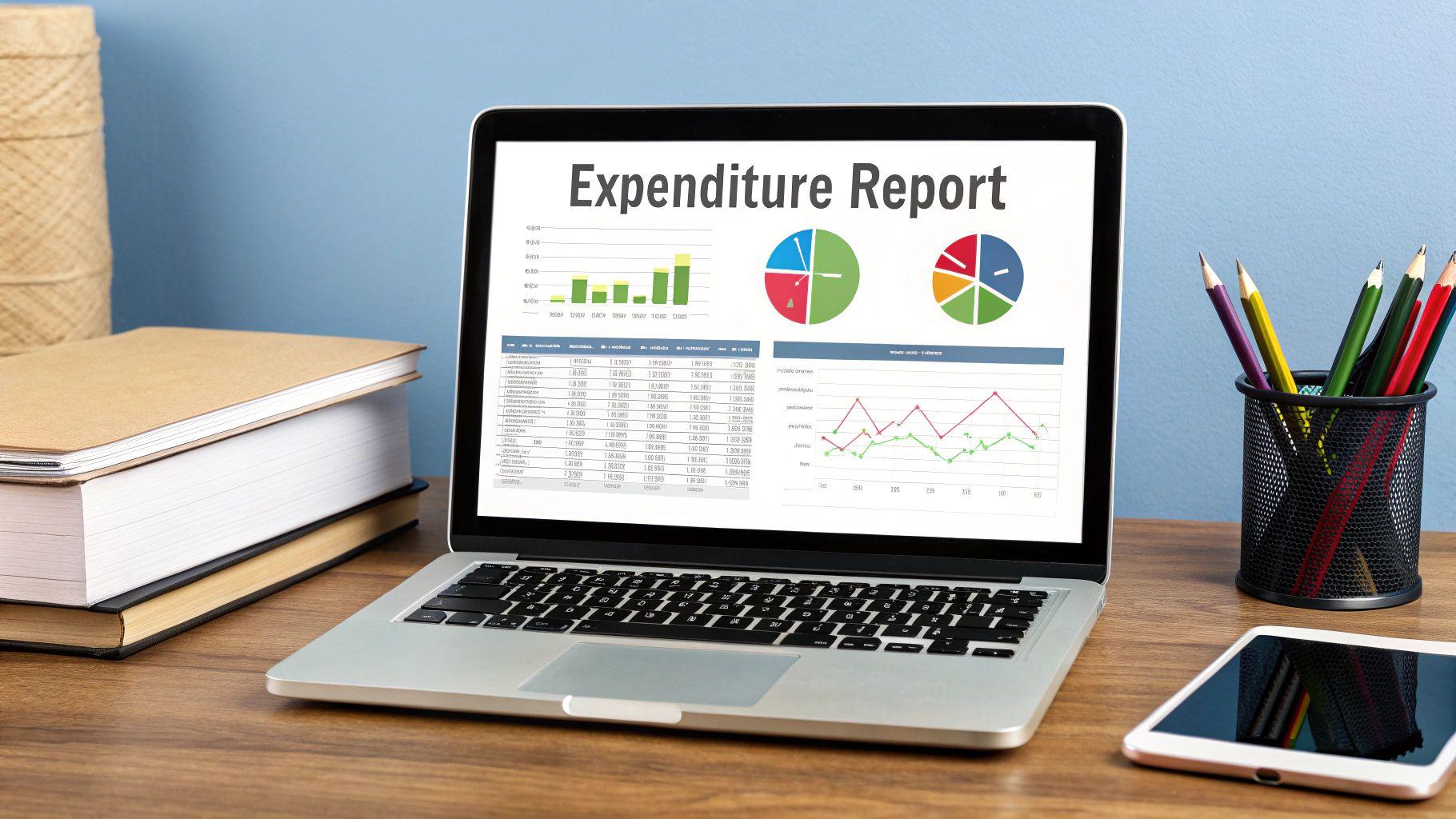How to Calculate Capital Expenditures for Real Estate
How to Calculate Capital Expenditures for Real Estate
Learn how to calculate capital expenditures (CapEx) with our expert guide, including formulas, examples, and tips to boost your investment strategies.
Domingo Valadez
Aug 4, 2025
Blog
When you need to get down to the brass tacks of calculating capital expenditures, there's a pretty standard formula that gets you there: CapEx = Current Period PP&E – Prior Period PP&E + Depreciation. This calculation pulls directly from your balance sheet and income statement, giving you a clear picture of what you’ve sunk into long-term assets over a given time. It’s a foundational metric for really understanding a property's financial state.
Why CapEx Matters in Real Estate Investing
Before we jump into the numbers, let's talk about why capital expenditures (CapEx) are such a big deal for any serious property investor. These aren't just figures on a spreadsheet. They represent the long-term health and future viability of your asset. Getting the "why" behind CapEx is what will help you make smarter moves, both during due diligence and for years down the road.
It helps to think about the practical difference between a capital expenditure and a routine operating expense (OpEx). If you have to fix a small leak under a tenant's sink, that's an OpEx—just a normal, everyday repair. But if you're replacing the entire building's 20-year-old roof? That’s a CapEx. It’s a major investment that fundamentally extends the property's useful life and boosts its overall value.
Protecting Your Asset's Value
Being able to accurately forecast these big-ticket expenses is your best defense against a property slowly falling apart. When you set aside funds for a new HVAC system or to repave the parking lot, you're doing more than just spending money. You are actively preserving—and often increasing—the property's market value, which keeps it competitive and desirable for tenants.
A well-funded CapEx plan is the financial equivalent of preventative medicine for your real estate asset. It prevents small issues from becoming catastrophic failures and ensures the property can weather any storm, financial or otherwise.
This kind of forward-thinking is absolutely essential for long-term success. It’s why so many savvy owners rely on expert property management services to oversee these projects, as they understand that protecting the asset is an ongoing job. If you ignore CapEx, you end up with a mountain of deferred maintenance that eats away at your property's value, creating a downward spiral that’s incredibly tough to escape.
For investors and sponsors, the technical calculation is just as critical as the concept itself. The standard formula is rooted in basic accounting logic: you look at the change in your Property, Plant, and Equipment (PP&E) and then add back the non-cash depreciation expense.
For instance, let’s say your PP&E grew from $50 million to $60 million in a year, and you recorded a $5 million depreciation expense. Your CapEx would be ($60M - $50M) + $5M = $15 million. This tells you exactly how much cash was invested back into the property's physical assets. You can find more detail on how this formula provides insight into a company's investment strategy on platforms like Prophix.
The Go-To Formulas for Calculating CapEx
When it comes to crunching the numbers on capital expenditures, there isn't just one way to do it. Experienced investors typically lean on a couple of core formulas, each pulling data from different financial statements to tell a slightly different story about your property's investment health.
The most common starting point uses your balance sheet and income statement. It’s a classic for a reason—it gives you a solid, high-level view of your actual investment in long-term physical assets over a given time.
Here's that primary formula:
CapEx = Net PP&E (Current Period) - Net PP&E (Prior Period) + Depreciation
Let's quickly unpack that. Property, Plant, and Equipment (PP&E) is just the accounting term for your tangible, long-term assets—think buildings, machinery, and land improvements. You'll find this number on your balance sheet. By subtracting last period's PP&E from the current one, you see the net change. But that's not the whole picture. You also have to add back the depreciation expense (which you'll find on the income statement) because it's a non-cash charge that lowers the book value of your assets.
This image really drives home how these major capital projects are at the heart of maintaining and boosting a property's long-term value.

You can almost feel the weight of those decisions—blueprints in hand, big machinery in the background. That's what CapEx is all about: planned, significant investments that keep a property competitive and functional.
Putting the Formula Into Practice
Let’s walk through a real-world example. Say you're reviewing the numbers for a multifamily property you acquired last year.
- Year 2 (Current Period) Net PP&E: $2,200,000
- Year 1 (Prior Period) Net PP&E: $2,000,000
- Year 2 Depreciation Expense: $75,000
When you plug these numbers into the formula, here’s what you get:
CapEx = ($2,200,000 - $2,000,000) + $75,000 = $275,000
This tells you that you’ve invested $275,000 back into the property's capital assets this year. This could be anything from replacing a commercial boiler and all the windows on the south side of the building to a complete repaving of the parking lot.
Expert Insight: The balance sheet method is fantastic for a high-level check-up. But be aware—it can sometimes get skewed by non-cash accounting events, like asset revaluations, which can make it seem like you spent more or less cash than you actually did.
Two Core Methods for Calculating CapEx
To make it simple, here’s a quick comparison of the two main ways to calculate CapEx.
Each method gives you a valuable perspective, whether you need a comprehensive accounting view or a direct look at cash movement.
An Alternative: Following the Cash
If you want a more direct, "show me the money" approach, your Statement of Cash Flows is the place to look.
Go straight to the "Cash Flow from Investing Activities" section. You'll usually find a line item clearly marked as "Purchase of property and equipment" or something very similar. This figure is the gold standard for understanding the actual cash that left your bank account for capital projects.
Many sponsors and I prefer this method because it cuts through the noise. It’s a direct measure of cash spent, stripping out any confusing non-cash accounting entries.
To get these numbers right, you absolutely need to track them accurately. Investing in the best rental property accounting software can make your life a whole lot easier by keeping these figures clean and ready for analysis. Ultimately, the formula you choose depends on what you’re trying to understand: the big-picture investment activity or the cold, hard cash impact.
Using the Depreciation to CapEx Ratio
So you’ve calculated your property's capital expenditures. That's a great start, but the real magic happens when you start to interpret what those numbers are actually telling you. One of the most insightful ways I’ve found to do this is by looking at the relationship between your depreciation expense and your CapEx.
This comparison, which you can think of as a simple ratio, tells a surprisingly clear story about your investment strategy. Are you in a heavy growth phase, pouring money into upgrades? Or are you just trying to keep things running smoothly? This ratio cuts through the noise and gives you a straight answer. Tracking it over time is even better—it helps you see what's coming down the pike and explain the property's financial health to your partners and investors in plain English.

This simple step moves your analysis from just crunching numbers to genuine strategic foresight.
What the Ratio Is Telling You
When you analyze the connection between depreciation and CapEx, you're essentially getting a snapshot of your asset replacement cycle. It’s a trick financial analysts use all the time to see how intensely a company is investing in itself.
For example, a company's depreciation-to-CapEx ratio might start at 66.7%. This means its depreciation expense was only two-thirds of what it was spending on new assets. An analyst might then forecast that this ratio will climb toward 100% over the next few years, signaling a strategic shift from aggressive expansion to a more stable, maintenance-focused phase. This kind of insight is invaluable for understanding long-term investment patterns.
A ratio consistently below 100% suggests you're investing more than what's depreciating. This usually means you're expanding or doing major upgrades. A ratio hovering around 100% indicates you're basically replacing assets as they wear out—a classic maintenance phase. If your ratio climbs well above 100%, it can be a red flag that you're falling behind and deferring crucial projects.
Of course, understanding CapEx goes beyond just the operational side; you have to think about the tax implications, too. Learning more about how capital improvements play into your overall strategy for landlord tax deductions can have a huge impact on your net returns. These aren't just expenses—they're strategic financial levers with long-term consequences for your property's value and your tax bill.
How to Accurately Forecast Future CapEx
Knowing your historical capital expenditures is one thing, but the real power comes from accurately predicting what's coming down the road. This is where seasoned real estate sponsors really shine. Proactive forecasting helps you build a solid, reliable budget that sets your property up for long-term financial health and growth.
It all starts with a thorough property condition assessment (PCA). Think of it as a top-to-bottom physical for your building. You, or a professional you hire, will need to walk the entire property and meticulously inspect every major system.

The point of the PCA isn't just to spot current problems. You’re trying to figure out what needs attention and, just as importantly, when. This means looking at a system and anticipating when it will reach the end of its useful life.
Budgeting Methods for Future Projects
With your assessment in hand, you can begin to build a forecast. A common, though basic, method is the per-unit reserve rule, which is especially popular in multifamily deals. Many investors will budget $250-$500 per unit per year for future CapEx. It’s a decent starting point, but it's a blunt instrument that isn't customized to your specific property's needs.
For a much more precise forecast, you’ll want to get granular by estimating the useful life and replacement cost for each of your property's major systems.
- Roofing: An asphalt shingle roof typically lasts about 20 years. If the one on your building is already 15 years old, you know a big-ticket replacement is looming in about five years.
- HVAC Systems: Central air systems might give you 15-20 years of service, but individual window units could tap out in as little as 10.
- Appliances: If you own a 100-unit building, you can reasonably expect to replace a certain number of refrigerators, stoves, and dishwashers every single year based on their average age and lifespan.
This detailed, system-by-system approach lets you move beyond a simple ballpark estimate and create a data-driven, year-by-year capital plan.
Your CapEx reserve fund is the financial safety net for your property. It’s there to handle everything from planned projects, like repaving the parking lot, to sudden emergencies—like a boiler giving out in the middle of a cold snap—without sending you scrambling for expensive, last-minute financing.
Ultimately, managing this reserve fund is a balancing act. It needs to be large enough to cover those future costs, but you also want to make strategic distributions to your investors. When managed well, a CapEx budget transforms a potential financial headache into a predictable, manageable piece of your overall investment strategy.
Where Even Smart Investors Go Wrong with CapEx
I’ve seen it happen time and again—even seasoned investors can get tripped up by capital expenditures. Knowing how to calculate CapEx is one thing, but knowing how to avoid the common pitfalls is what separates the pros from the pack. Steering clear of these traps is absolutely essential for protecting your deal’s numbers and the long-term health of your property.
Misclassifying Your Expenses
One of the biggest blunders is confusing a capital improvement with a simple repair. It's an easy mistake to make. Replacing a few cracked floor tiles? That's a repair, an operating expense (OpEx). Retiling the entire lobby to upgrade the building’s look? That's a capital improvement (CapEx).
Getting this distinction wrong isn't just a bookkeeping headache. It can seriously mess up your financial statements and, more critically, your tax filings, leading to incorrect depreciation schedules and attracting unwanted attention from the IRS.
Forgetting About Tomorrow's Costs
Another classic mistake is creating a CapEx budget based only on today's prices. It’s a dangerous oversight. Investors often map out their needs but completely forget that inflation will drive up the cost of both labor and materials.
That new roof you budgeted $50,000 for today could easily cost $65,000 or more by the time you actually need it in five or ten years. This kind of miscalculation leads directly to an underfunded reserve account, which is a ticking time bomb for any property.
When a major system inevitably fails and there isn't enough cash set aside, sponsors get backed into a corner. This either leads to costly deferred maintenance that tanks the property's value or forces an unplanned—and very unpopular—capital call from your investors.
Thinking ahead about CapEx isn’t just about preserving the asset; it’s about smart financial strategy. Properly navigating these costs, including the powerful real estate investment tax benefits tied to depreciation, can turn necessary expenses into a major financial advantage for your deal.
Common CapEx Questions Answered
Even when you feel like you have a handle on calculating capital expenditures, some tricky questions always seem to pop up. Let's walk through a few of the most common ones I hear from real estate sponsors to help you sharpen your strategy and keep your financial reporting on point.
What Is the Difference Between CapEx and OpEx?
I find it helps to think about it in simple terms. Capital Expenditures (CapEx) are the big-ticket items—the major investments you make that either add significant value to a property or extend its useful life. Think replacing an entire roof or installing a brand-new HVAC system. These are capitalized on your books and depreciated over several years.
Operating Expenses (OpEx), on the other hand, are all the routine, day-to-day costs of just keeping the lights on and the property functional. We're talking about utility bills, landscaping services, or fixing a simple leaky faucet. You expense these costs in the same year you incur them. The key difference is long-term value creation (CapEx) versus daily maintenance (OpEx).
How Much Should I Budget for CapEx Reserves?
Everyone wants a single magic number, but the truth is, it depends. A widely used rule of thumb is to budget between 1-3% of the property's total value each year for reserves. For multifamily sponsors, a more granular approach is budgeting $250 to $500 per unit, per year.
That said, rules of thumb are just a starting point. The absolute best practice is to roll up your sleeves and conduct a thorough capital needs assessment. This detailed, property-specific forecast will map out the expected replacement timeline and costs for every major system, giving you a far more accurate budget than any generic percentage ever could.
Can I Deduct CapEx from My Taxes in One Year?
This is a critical distinction that trips people up, and the answer is almost always no. You can't just write off a major capital improvement in the year you pay for it.
Instead, CapEx must be capitalized and then depreciated. This means you get to deduct a portion of the total cost each year over the asset's "useful life" as defined by the IRS. For residential rental properties in the U.S., that's typically 27.5 years. As always, make sure you're talking to a qualified tax professional to stay compliant.
Juggling these financial details across a growing portfolio can quickly become overwhelming. This is where a tool like Homebase comes in, streamlining everything by bringing your deal management, investor relations, and financial reporting into one place. You can focus on growing your portfolio, not your paperwork.
Share On Linkedin
Share On Twitter
Share On Linkedin
Share On Twitter
DOMINGO VALADEZ is the co-founder at Homebase and a former product strategy manager at Google.
What To Read Next
Real Estate Syndication Structures: Your Guide to GP/LP, LLC, and JV Models
Blog
Explore real estate syndication structures and compare GP/LP, LLC, and JV models with practical insights and real-world scenarios to guide your deal.
Sign up for the newsletter
If you want relevant updates from our team at Homebase, sign up! Your email is never shared.
Sign up for the newsletter
If you want relevant updates from our team at Homebase, sign up! Your email is never shared.
© 2025 Homebase. All rights reserved.